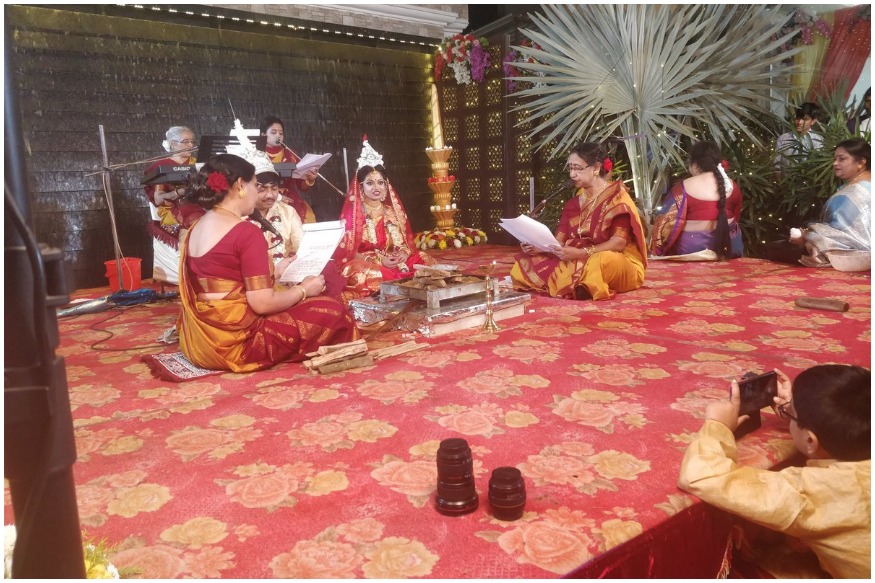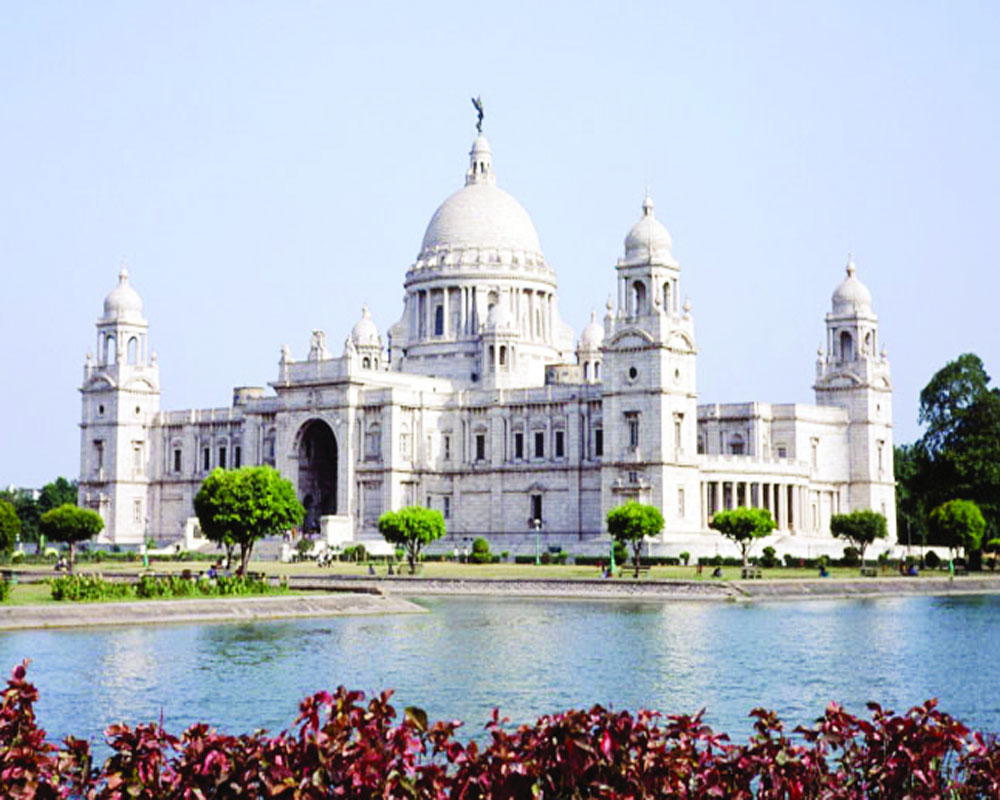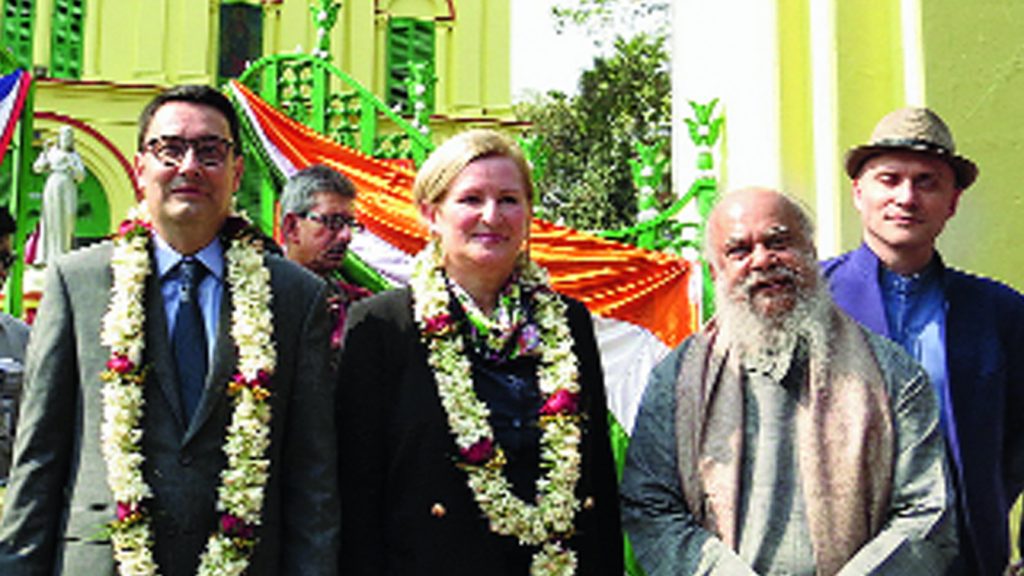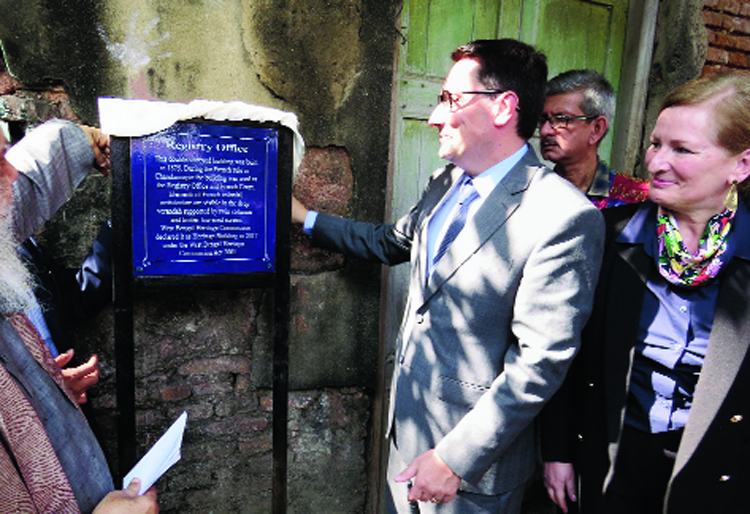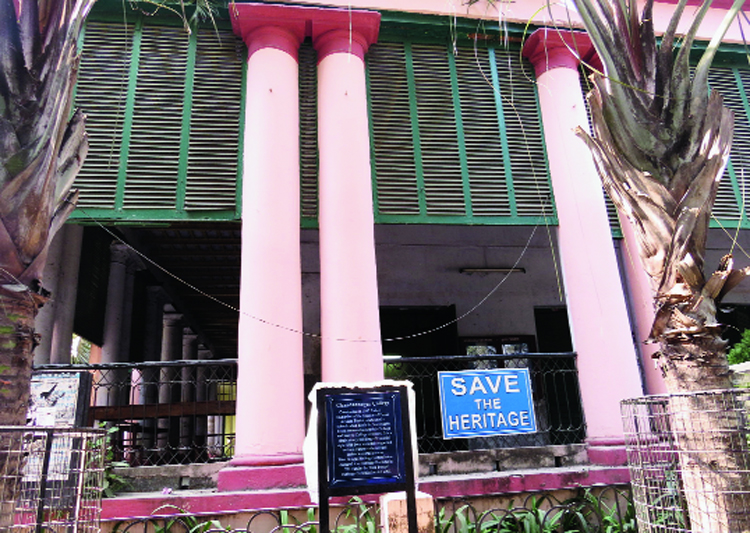
Bhadis make their way through Kolkata’s streets, carrying two plastic cans of water on an eight-foot-long bamboo pole balanced on their shoulders. | Photo Credit: Debajyoti Sarkar
The circadian rhythms of a bhadi’s life are dictated not by sunrise and sunset, but by the Kolkata Municipal Corporation
The frayed soles of his black rubber sandals scraping against the gravel, his body canted forward for balance, his steps quickened by the burden he carries, Chintamani Palai makes his way through Kolkata’s Shyampukur Street where houses look like boxes jostling for space. At either end of the eight-foot bamboo pole he carries on his shoulders hang two large, fluorescent yellow, plastic jerrycans filled with water that sloshes with every step.
It is Palai’s 21st trip of the day, between the municipal tap at the end of the street and back to the various homes, where he sells the water at ₹2 per can of 15 litres.
“I don’t need water today,” says Arup Ghose, a resident.
“You don’t? Ah! But I have brought it for you. I don’t like to throw away the water. Don’t give me money.”
“Okay. Fill the tank then.”
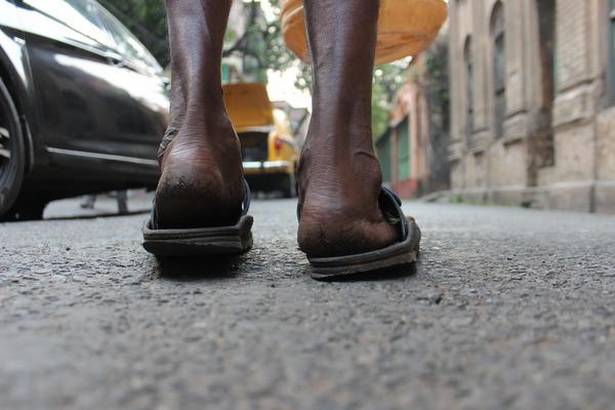
The numbers of bhadis in Kolkata are declining: from thousands even a decade ago they are down to a few hundreds now. | Photo Credit: Arpita Chakrabarty
Palai removes his sandals, climbs up two floors to the terrace, and upends his two cans into a plastic tank. He is now back on the street, his stooped shoulders a visible imprint of his profession, on his way to fill the cans again.
Palai moved to Kolkata from his hometown in Odisha 33 years ago. He is a bhadi – literally, one who carries the load.
Where are the jobs?
Odia bhadis have quenched thirsty Bengali homes for as long as one can recall. Palai’s father was a bhadi; so were his grandfather and great-grandfather. The work they do doesn’t count as registered employment — this is ‘make-work,’ necessitated by migration, unemployment and water scarcity. Back home in Odisha’s Bhadrak district, Palai could not find a stable job that would provide for the 22 members of his family. His family owns half an acre of land; his three brothers work intermittently as farm labourers, construction workers and dairy farmers. “Most of the work is seasonal, so we can’t depend on it throughout the year,” says Palai.
And so, able-bodied men like Palai have been migrating to eastern India’s biggest metropolis to look for work for decades now. Those without specific skills like cooking or plumbing end up as bhadis. But paradoxically, even though unemployment and migration is on the rise, the numbers of bhadis in Kolkata are declining: from thousands even a decade ago they are down to a few hundreds now.
“It’s a strenuous job,” says Palai. “Those of us who were trained by our fathers and grandfathers continue to work, but the young people don’t want to be bhadis anymore. They want easy, light jobs.”
***
Palai left Odisha when he was just 12. “It was the year Indira Gandhi was killed. The political atmosphere in Kolkata was volatile. So I ran back home, and returned to Kolkata a year later. I finally began working as a bhadi in 1985.” His smile is broad, his teeth are stained from the paan he chews incessantly, mostly to dull the ache of hunger and fatigue.
The circadian rhythms of a bhadi’s life are dictated not by sunrise and sunset, but by the Kolkata Municipal Corporation. The corporation releases water to the taps between 5 a.m. and 9.30 a.m., then again between 3 p.m. and 6 p.m.. In hours in between, he fills water from tubewells in the area and delivers it to those who need extra water, or who prefer tubewell water to tap water for washing. By noon, he has already ferried 990 litres of water, criss-crossing the lanes of north Kolkata. “I never counted this, all my life,” laughs Palai. “Today, when I keep a count with you, it seems quite a job.”
In the few hours that I shadow him, plotting his back and forth trips on Google Maps, I find that he has walked 5.11 km. In this time he has refilled his jerrycans 43 times, stopped at 26 homes, climbed three or more flights of stairs several times over.
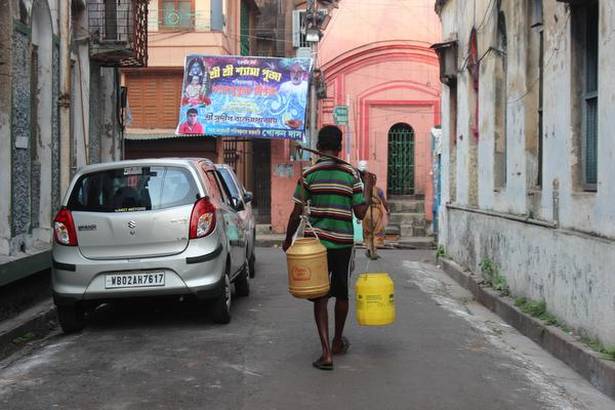
The work they do doesn’t count as registered employment — this is ‘make-work,’ necessitated by migration | Photo Credit: Arpita Chakrabarty
He squeezes in a couple of hours for lunch. It’s usually rice and fish curry. Outside the small, square single room that he shares with another bhadi and two jhalmuriwalas (men who sell the spicy, puffed rice street food), all from Odisha, pieces of rui fish are being fried on a kerosene stove. Inside, the men are busy chopping potatoes for the fish curry. Another bhadi, back from work, is crushing poppy seeds on a sil batta, working it into a creamy paste that will go into the curry.
Jhalmuri brothers
“We cook and eat together,” says Palai. “This is our bonding time. We talk, make fun of each other. There is no time for any of this in the evening — by the time the jhalmuriwalas return home, it’s close to midnight, and we are asleep.” After a short siesta, Palai is back at the taps. Now there aren’t as many people as there were in the morning, but Palai is still impatient; he has dozens of homes to deliver to before the water is shut off at 6 p.m.
“I have a client whose landlord doesn’t provide any water,” says Palai, chewing paan as he waits in line at the tap. “So I supply them 90 litres of water two times a day.” Most of his regulars are inherited — his father once delivered water to them — and so this equation is much more than transactional: both bhadi and customer have built up a relationship neither wants to forego.
“We have piped water in our house,” says Archana Dasgupa, a septuagenarian who lives on Shyampakur Street. “But Palai is more than a bhadi to us; his grandfather delivered water to my father-in-law in the 1940s. He’s now a part of our family.”
In a city whose young have been migrating out in increasing numbers, Palai and his peers are valuable resources for the ageing population left behind: Kolkata has the biggest 60-plus population of any city in the country, and it also has the least number of 20 to 30 year-olds among all the metros. “Without our children, we depend on men like Palai for other regular jobs too, like buying groceries, cleaning the house, fetching water from the Ganges for the puja, and so on,” says Dasgupta.
The price of delivery has increased from 20 paise per can in the 1980s to ₹2 in 2018. But, says Palai, he doesn’t charge everyone the same price. The West Bengal State Cooperative Bank, where he delivers, pays him a modest salary of ₹3,200 per month. “I started with ₹20 when I joined the bank in the 1980s.” Palai’s family has been delivering water ever since the branch was established 50 years ago.
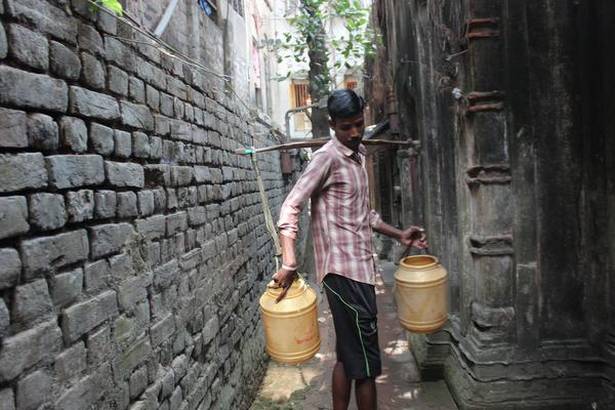
Odia bhadis have quenched thirsty Bengali homes for as long as one can recall | Photo Credit: Arpita Chakrabarty
After filling, carrying, emptying, refilling, and carrying water on his shoulders every day of the week, Palai earns ₹9,000 a month. “There are days when somebody’s water pump breaks down, and I fetch water for them till they repair it. I supply water for weddings. My earnings rise at such times.” He sends half his earnings home to the village. He is not unhappy, but his legs have begun to hurt more often, so he has begun to take painkillers.
He may well be the last bhadi in his family. “I want my son to study hard and get a proper job. I tell him, become something else. If you live as a bhadi, you die a bhadi.”
***
The Hooghly River flows west of Kolkata; there’s a huge groundwater reserve. The city’s eastern fringes are covered with wetlands that naturally treat waste water into raw water for fisheries and agriculture. Two decades ago, only a handful of houses in the city had piped water supply. Bhadis formed the water army who supplied water for drinking and washing across households. “There was an acute water crisis in those days, and it was the bhadis who brought water to our homes, like they do now.”
Manual support
Today, the demand for bhadis is lower. Five water treatment plants have boosted water supply to Kolkata’s homes. But the city now grapples with depleting groundwater. As independent houses turn into multistoreyed apartments pumping their own water from large tubewells, they deplete the city’s natural groundwater reservoirs.
In some places, the corporation does not supply water at the right pressure for it to be piped to above-ground storage tanks. Says Arunabha Majumdar, Chairman, Indian Water Works Association, “The residents then depend on the manual support system, the bhadis, to fetch water.”
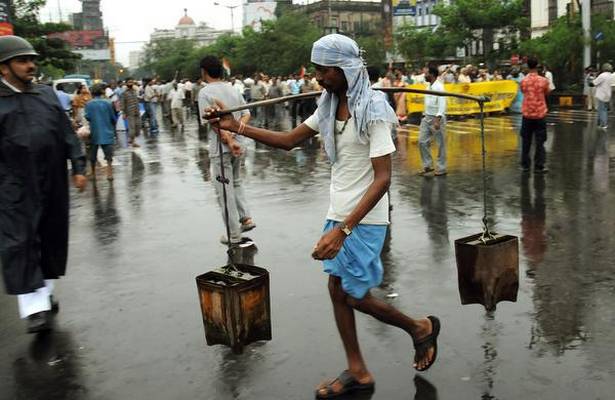
A bhadis in Kolkata | Photo Credit: Arunangsu Roy Chowdhury
Like 77-year-old Shyamal Mitra. “Every summer we face an intense water crisis. The piped corporation water is not regular. The supply pipeline has no pressure and water cannot be pumped up to the first and second floors,” says Mitra.
A floating population of six million per day — greater than the city’s resident population of 4.4 million — also depends on public water taps. The city, within the municipal corporation limits, draws 300 gallons of drinking water a day from 18,000 water taps, 12,000 hand tubewells and 400 tubewells.
High levels of arsenic have been found in the groundwater in various parts of Kolkata. The prolonged water depletion raises the risk of contamination, especially in the areas that are heavily dependent on groundwater, forcing them to turn to bottled water and the service of the bhadis.
Corporation tap water has been found to be safer than the packaged water sold in the city, and to contain more minerals and to be less acidic.
Since bhadis fetch water from Corporation taps, they are still getting takers.
***
Pitabas Parida has been supplying water for just two years in the Bagbazar area. Parida, who belongs to Odisha’s Jujpur district, has travelled to all major metros looking for work. He worked in a fibre factory in Bengaluru, made milk packets in Chennai, shaped iron rods in Hyderabad, and worked as a farm labourer back home, before coming to Kolkata.
He has no house in the city. Parida and another bhadi live in a dilapidated Shiv temple in Bagbazar. It is surrounded by high-rises and wild shrubs have taken over its crumbling walls. The duo’s belongings — some clothes, two mobile phones, two chargers, and two thin mattresses — take up a corner of the temple. Parida eats at a local dhaba and uses public toilets.
Around the temple are water cans of all sizes. It is wise to keep them there because no one will steal from the house of god. Parida, 38, a frail man whose bony face is his most striking feature, delivers water to 30 houses every day.
“Why do you this job?” I asked him.
“Back home there’s nothing I can do for a livelihood. Besides, Kolkata is close to home. This is my life,” he said.
Men like Palai and Parida make up Kolkata’s invisible water distribution system. It is hard labour for little money, but it is all they know.
This essay is from a National Geographic Society and Out of Eden Walk journalism workshop.)
The Uttarakhand-based writer explores the lives of those who walk mountains.
source: http://www.thehindu.com / The Hindu / Home> Society> Cover Story / by Arpita Chakrabarty / February 09th, 2019
